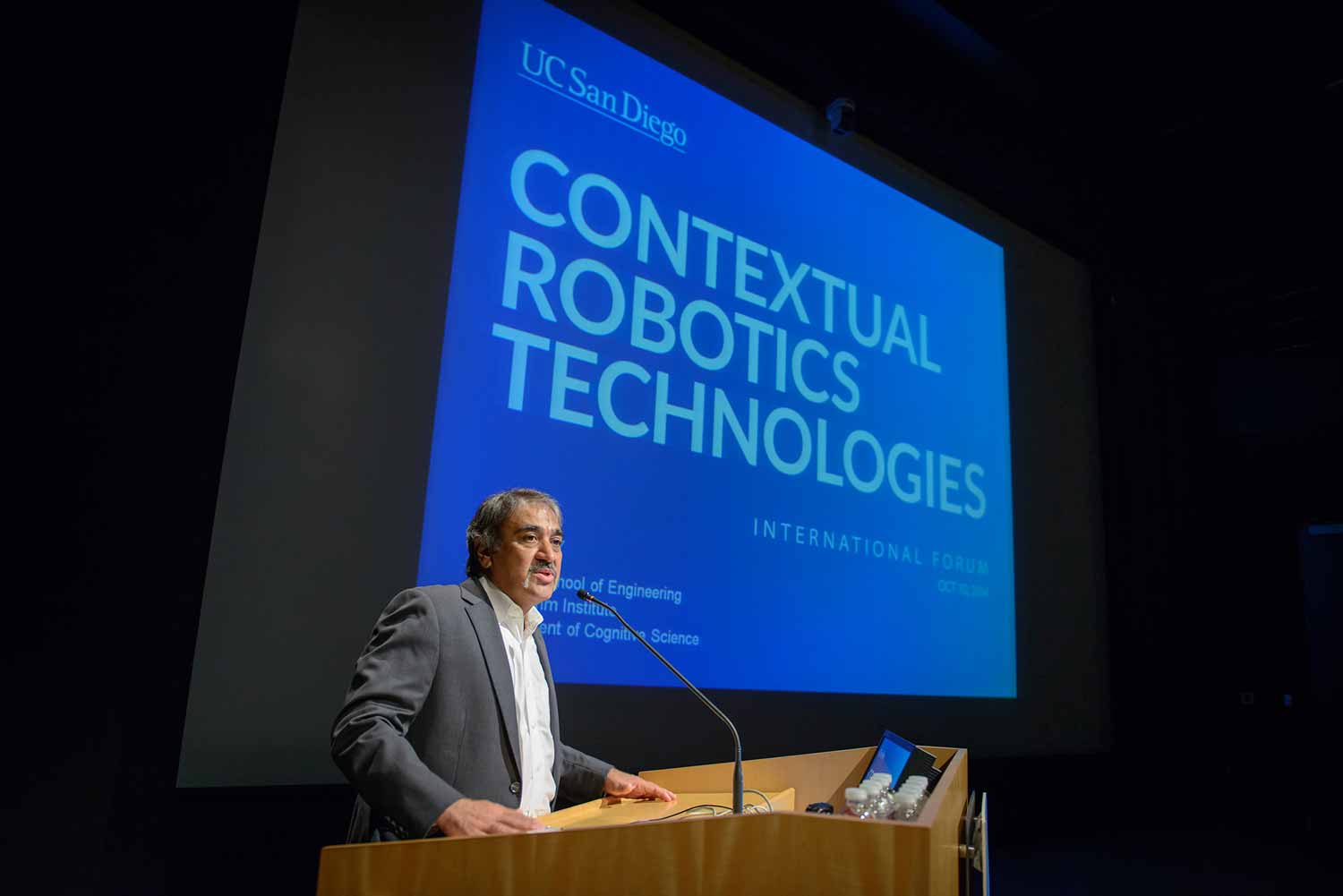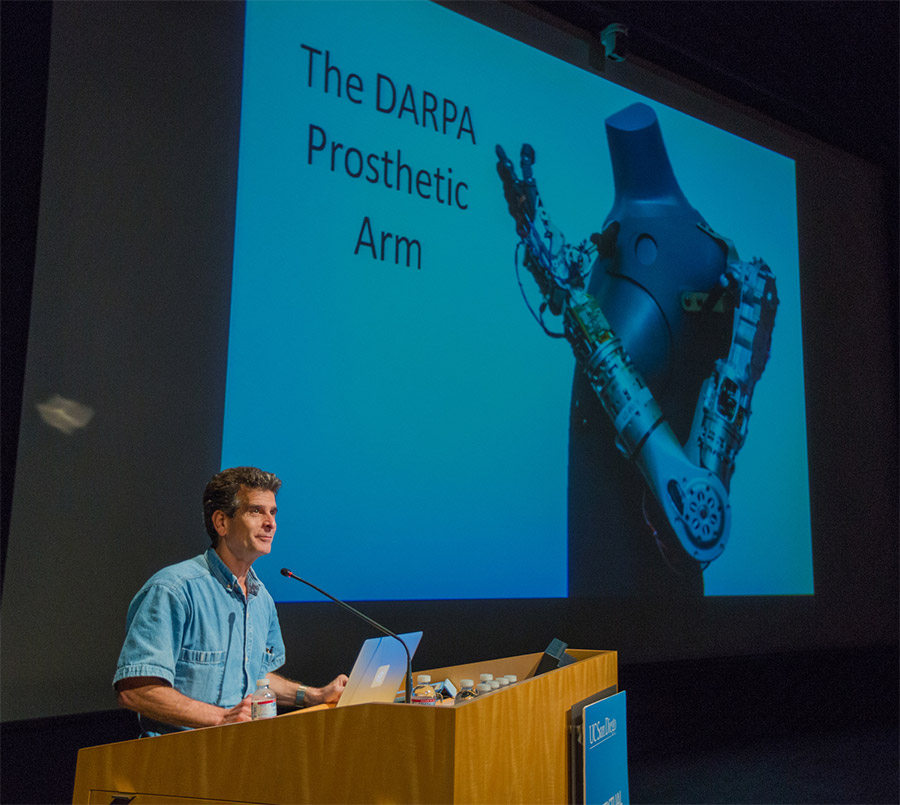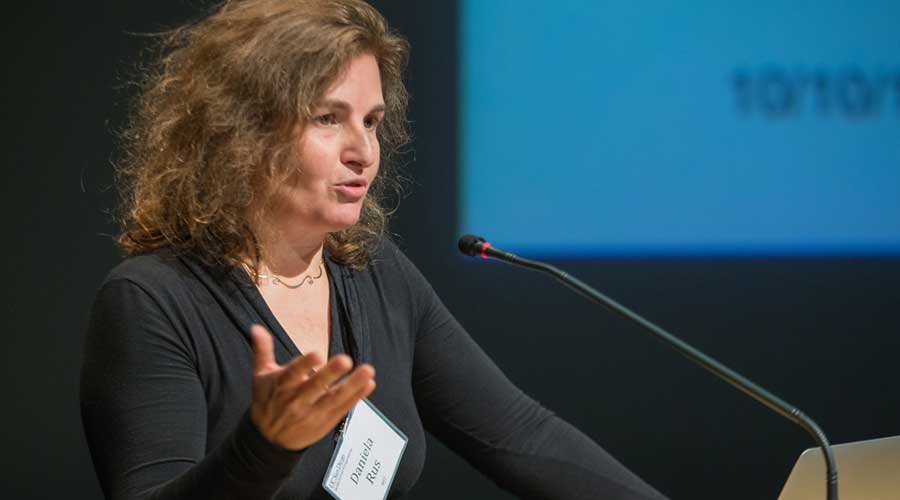Robotics Legends Converge at UC San Diego Forum
By Ioana Patringenaru and Daniel Kane
San Diego, Calif., Oct. 17, 2014 — After the industrial revolution and the Internet revolution, we are now poised for the robotics revolution. Influential robotics researchers and industry leaders made this prediction in many different ways Friday at the Contextual Robotics Technologies International Forum at the UC San Diego Qualcomm Institute. The speakers and more than 250 attendees gathered to reflect on what opportunities and challenges this revolution would bring, and how San Diego fits into this picture.

“Robots in the next couple of decades are going to transform the world the way engines did,” Dean Kamen, founder of DEKA Research and Development and inventor of the Segway two-wheeled balancing electric vehicle, said during the event.
The forum is part of a campus-wide move to focus more on robotics and leverage existing expertise in a variety of related fields and technologies. “UC San Diego needs to take a leading role in this area,” said UC San Diego Chancellor Pradeep K. Kholsa at the event. “We want to educate our students for the future of engineering.”
And this future most certainly includes robotics.
“As part of its investment in robotics research and education, the Jacobs School of Engineering is committed to hiring five faculty members in the robotics field in the next two hiring cycles,” said Albert P. Pisano, Dean of the Jacobs School of Engineering. The school already has hired Michael Tolley, an expert on soft robotics and self-folding robots.

“We have all the pieces required for the San Diego area to become a worldwide hub in robotics,” Pisano said, pointing to the local defense and wireless industries, as well as manufacturing facilities across the border in Tijuana.
Partnering will be crucial for the creation of the robotics hub, said Qualcomm Institute Director Ramesh Rao. “A world class ecosystem will emerge here once UC San Diego steps in more fully—in partnership with other key players,” he said. Rao, who served as MC for the event, is a professor of electrical and computer engineering at the Jacobs School.
Matt Grob, Executive Vice President, Qualcomm Technologies and CTO, kicked off Friday’s series of keynotes by flying a mini quadcopter over the audience. One big challenge facing the robotics community is battery technology, which, he noted, has only improved by 6 to 7 percent a year, on average.
“I like to think, especially in this field, what would happen if we had 10 times better batteries,” he said. “We’d really have some capability for doing some mobile robotics. I think it will happen. There is huge demand.”
Robotics today: health care, drones and industrial robots
Drones, like the mini quadcopter Grob flew, are at the forefront of the robotics revolution. In the consumer space, much of that is due to 3D Robotics, whose CEO, Chris Anderson, also spoke Friday.
Ten years ago, drones like those sold by 3D Robotics were essentially $10 million DARPA projects, he said. Today, they can be bought at the mall. “I can’t think of another industry that has consumerized as quickly as this,” Anderson said.
Robotics technologies are also currently embedded in a wide range of medical devices that are helping improve the lives of a large number of patients, including people who have lost a limb or the ability to walk.
.jpg)
For example, engineers at Kamen’s DEKA Research developed with DARPA funding a prosthetic arm that is capable of picking up grapes without crushing them. The company also developed the iBOT, a wheelchair that functions on the same principle as a Segway, allowing users to go over curbs, climb stairs and even “stand” to see eye to eye with others.
Where we are headed: eldercare, search and rescue and nanomachines
Robots also will be key to help care for the United States’ aging population, Rodney Brooks, CTO of Rethink Robotics and co-inventor of the Roomba floor vacuuming robot, predicted. But to get there, researchers face three major challenges: robots need to be able to get around obstacles in a home; they need to be able to grasp objects; and they need to able to interpret the messy context of everyday life.
Daniela Rus, an MIT professor, is tackling some of these issues. “Robotics is where computer science was before compilers,” which translate more complex programming languages into languages that allow the computer to actually execute commands, Rus said.
The trouble is that many robots are currently expensive and take a long time to develop and build. Rus sees opportunities to democratize robotics and make robots more accessible to all through approaches such as self-folding robots and 3D printing.
Meanwhile, Vijay Kumar, a professor at the University of Pennsylvania, is working on improving the way robots perceive and interact with the environment and communicate with each other. His platform of choice: swarms of small quadcopters. These robots could be extremely useful in rescue situations. “Imagine swarms of robots flying and collecting all this data and when they come out of the building, all that [data] gets sucked into the cloud and reconstructed so that a human first responder can then decide what’s the best course of action,” he said.
People who are interested in looking ahead to where U.S. defense robotics funding will be going should move away from the mindset that it’s about the battlefield, said DAPRA program manager Gill Pratt. Instead, it’s about automating more support functions and driving costs down.

While many robotics researchers build on a big scale, some, like Brad Nelson of ETH Zurich, explore the infinitesimally small. His students have developed a robot at the micron scale that can be attached to a tether and inserted inside the human body via a catheter. The robot can then be steered by using magnetic fields to work inside the human heart or collapsed lungs. “The field has huge potential,” Nelson said.
Educating tomorrow’s roboticists
In coming years, robotics hubs like the one envisioned for San Diego will need a trained workforce. To help build a pipeline for engineers in the future, Kamen co-founded FIRST, a robotics competition, which engages and inspires kids through exciting robotics challenges.
“We have to change the culture of the country,” Kamen said. “We got to make engineering cool, particularly to women and minorities.”
The audience had positive reactions to the event. UC San Diego alumnus Matt Borzage, (BS ’06, bioengineering) drove down from Los Angeles to attend the robotics forum. Borzage is a co-founder and head of business development at SynTouch, a company that makes tactile sensor technologies that give robots the ability to replicate the human sense of touch. “I’m proud to see my alma mater take a lead in the field,” he said.
* * *
The Contextual Robotics Technologies International Forum was hosted by the Jacobs School of Engineering, the Qualcomm Institute and the Department of Cognitive Science.
Additional videos from the event will be posted next week at: http://www.jacobsschool.ucsd.edu/contextualrobotics/index.shtml
Media Contacts
Daniel Kane, Jacobs School of Engineering, (858) 534-3262, dbkane@ucsd.edu
Ioana Patringenaru, Jacobs School of Engineering, (858) 822-0899, ipatrin@ucsd.edu

